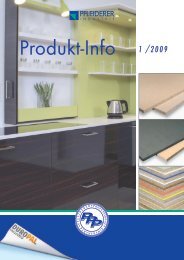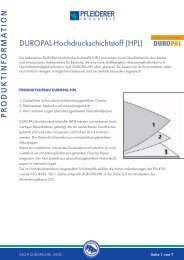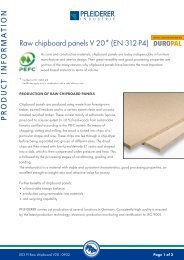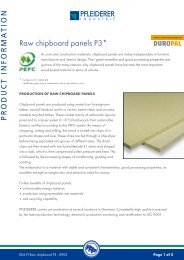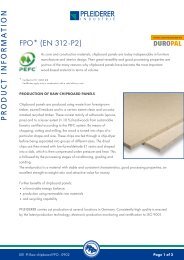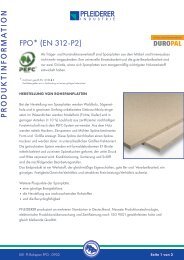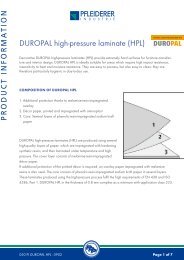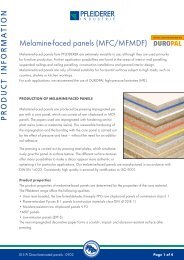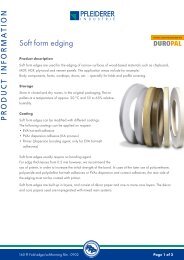Processing and working instructions HPL and HPL elements PR ...
Processing and working instructions HPL and HPL elements PR ...
Processing and working instructions HPL and HPL elements PR ...
Create successful ePaper yourself
Turn your PDF publications into a flip-book with our unique Google optimized e-Paper software.
<strong>PR</strong>ODUCT INFORMATION<br />
7. WOrKINg WITH DUrOPAL <strong>HPL</strong> AND DUrOPAL <strong>HPL</strong> ELEMENTS<br />
7.1 general<br />
DUROPAL <strong>HPL</strong> with a thickness of less than 2 mm needs a flat, stress-free core material with minimum flex.<br />
A smooth surface is an essential requirement for a permanently good result. The right adhesives, application<br />
quantity, pressure <strong>and</strong> press temperature are equally important.<br />
Since DUROPAL <strong>HPL</strong> may be subject to slight dimensional changes, depending on the air humidity <strong>and</strong><br />
temperature, these properties must always be taken into account when <strong>working</strong> with DUROPAL <strong>HPL</strong>.<br />
7.2 Core material<br />
The following table describes the suitability of different materials as cores <strong>and</strong> their application possibilities.<br />
With all such information, it should be noted that the properties of a core materials of different composition<br />
(e.g. honeycomb with frame) can have an effect on the surface texture of the DUROPAL <strong>HPL</strong>. This should<br />
be checked in advance <strong>and</strong> taken into account.<br />
Material/properties <strong>and</strong> suitability as core material<br />
Chipboard panels<br />
On free supporting constructions, the necessary thickness must be taken into account.<br />
The fixing of the flat bonded element depends on the thickness <strong>and</strong> size of the panel.<br />
The surface quality of the DUROPAL <strong>HPL</strong> element depends largely on the structure of the<br />
chipboard panel construction, i.e. the shape of the chips, resin content, density, <strong>and</strong> in<br />
particular on the s<strong>and</strong>ing quality of the surface. Multi-ply chipboard panels are suitable<br />
as core materials. The panels should be evenly s<strong>and</strong>ed on both sides in order to prevent<br />
bowing <strong>and</strong> visual surface defects.<br />
In order to enable a short bonding <strong>and</strong> pressing time, ensure good surface absorption<br />
properties if you are using water-based bonding system. The surface must also have a<br />
resistance to delamination strength of at least 1.2 N/mm2 to avoid detachment of the<br />
laminate (DIN 52 366). Please contact us in the event of any further questions on these<br />
special chipboard panels.<br />
099 PI <strong>Processing</strong> <strong>and</strong> <strong>working</strong> <strong>instructions</strong> Page 14 of 34



